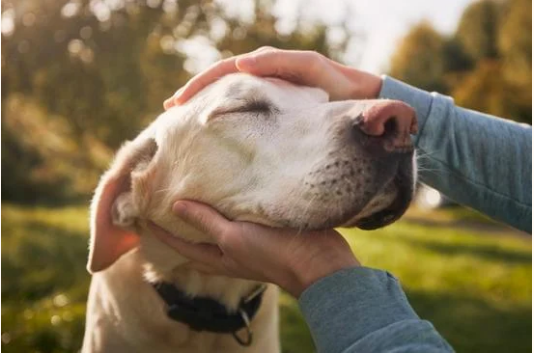
Caring for an aging dog requires special attention: our four-legged friends don’t stay young forever! Their needs evolve with age, and they require more attention from us.
When does a dog become senior?
A dog’s breed and size influence when it is considered senior.
However, a senior dog may be perfectly fit until gradually more important signals appear, indicating that he’s losing mobility and vitality.
- Small dogs (up to 9kg): senior from age 8. Life expectancy: 11-19 years
- Medium (from 9 to 22kg): senior from 7 years. Life expectancy: 10-16 years
- Large (22 to 55kg): senior from age 7. Life expectancy: 8-12 years
What are the most important signs of aging?
Your companion runs less on walks and slower than before. He may have difficulty getting up, especially in the morning after a night of lying down. There may also be a loss of hearing, a greying coat, diminished eyesight, a change in character, joint pain…
What are the solutions?
- Set up his environment
Create a cozy, quiet little nest for him, so as not to irritate him, keep him out of stress and avoid changing his habits. A more comfortable basket may be welcome to reduce joint pain. Ideally, he doesn’t need to go up or down stairs to eat or drink.
- Adapting his diet
Your dog’s needs change with age, so ask your vet for advice on the right food for senior dogs.
- Protect him from temperature changes
Older dogs are more sensitive to temperature changes. The cold and damp of winter can bring on joint pain, so be sure to keep him warm! In summer, hot weather tends to make your dog more tired, so keep him cool and minimize his exertions.
- Going for walks
Don’t worry, a senior dog always likes to go for a walk! Physical exercise is always good for keeping him in shape. On the other hand, he’ll tire more easily, so opt for shorter walks. If he stops, don’t hesitate to turn around and walk him again later in the day.
- Regular check-ups
Regular check-ups with your vet are essential to protect your companion’s health. Early diagnosis always helps to better treat any illness.
Osteoarthritis in senior dogs
What is osteoarthritis?
Osteoarthritis is a chronic disease. It affects the dog’s joints (hip, knee, elbow, but also the spine.) It is due to the progressive destruction of cartilage, the membrane that covers the bones in the joints and normally cushions shocks. Osteoarthritis affects dogs in a similar way to humans.
Osteoarthritis is particularly prevalent in large and medium-sized dogs, although small dogs can also be affected.
Symptoms of osteoarthritis
Osteoarthritis often starts with age, from 7 years onwards, although it can also affect younger dogs. Osteoarthritis causes chronic pain of varying severity, leading to discomfort and even disability in dogs who can no longer carry out their daily movements (climbing stairs, jumping, running, etc.).
Symptoms are generally stiffness when the dog moves, or a limp on a daily or occasional basis. Your dog will pant more easily under stress due to the effect of pain, and may even refuse to play or go for a walk. Your dog may also feel pain when you touch him, change his behavior and eat less.
How can I help my dog?
Osteoarthritis is a chronic, progressive disease that cannot be cured. But dogs can live with it for many years, and there are treatments available to stabilize osteoarthritis and relieve your friend of the pain.
- Ask your vet for advice
Osteoarthritis can be treated on a daily basis or in the event of an attack. Early diagnosis can help slow the progression of the disease.
- Swimming
Swimming helps your dog’s joints. It’s a gentle way of exercising your dog’s muscles. Of course, if your dog doesn’t like swimming, don’t force him either!
- Massages
You can massage your dog’s painful areas yourself. It’s a gentle, relaxing treatment that usually improves blood circulation to the muscles. Massage relieves muscle tension and normally releases a natural analgesic from the body. It’s a moment enjoyed by both owner and pet!
- Avoid humidity/cold
Joint pain is particularly prevalent in winter, so make a warm, cosy nest for your pet, and pay special attention to him at this time of year. It’s a good idea to use a blanket to keep your dog’s muscles from stiffening.
- Keep your dog walking
It’s essential that your dog continues to exercise his muscles regularly, to reduce stiffness. Walks should be shorter but regular, and you should stop if he asks. He’ll always appreciate the time spent with you, and this will continue to stimulate him.
- Don’t make him put on weight
The effects of osteoarthritis are aggravated by excess weight, so you need to watch your dog’s diet to make sure he doesn’t put on weight, or even lose weight if he’s already overweight.
Osteoarthritis attacks
A dog suffering from osteoarthritis may go through an episode of acute, intense pain, known as an osteoarthritis attack. In these moments, he may be blocked, unable to get up. He may shake, pant and not want to eat. When these symptoms appear, stay with him and reassure him. Don’t panic in front of him, as your presence soothes him, and call a vet. The vet will be able to provide anti-pain treatment to disinflame the area, either by medication or injection. Once the seizure has passed, the dog’s condition will be stabilized and he’ll be able to walk again, even if his stiffness can sometimes worsen following a seizure.
Finally, don’t forget to spend quality time with your companion, and to remain calm and relaxed in his company. Your dog will always appreciate spending time with you!
